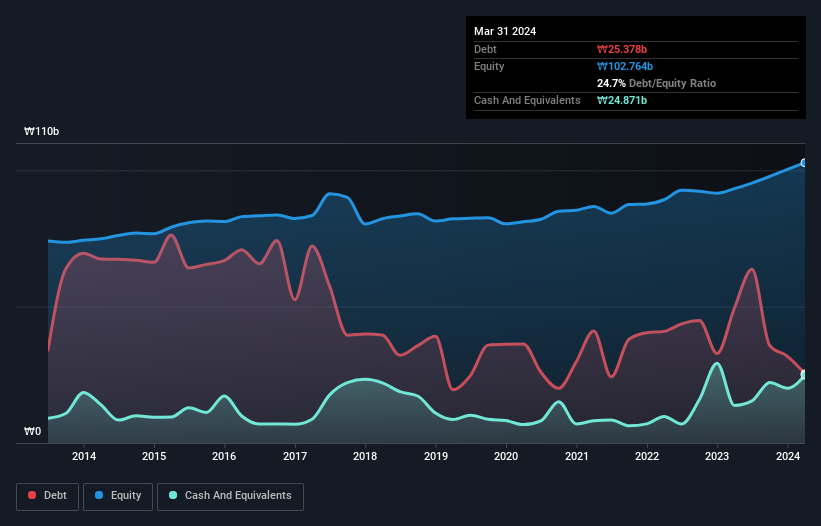
Some say volatility, rather than debt, is the best way to think about risk as an investor, but Warren Buffett famously said that 'Volatility is far from synonymous with risk.' So it seems the smart money knows that debt - which is usually involved in bankruptcies - is a very important factor, when you assess how risky a company is. As with many other companies Daewon Cable. Co., Ltd. (KRX:006340) makes use of debt. But is this debt a concern to shareholders?
Why Does Debt Bring Risk?
Debt assists a business until the business has trouble paying it off, either with new capital or with free cash flow. Ultimately, if the company can't fulfill its legal obligations to repay debt, shareholders could walk away with nothing. While that is not too common, we often do see indebted companies permanently diluting shareholders because lenders force them to raise capital at a distressed price. Of course, debt can be an important tool in businesses, particularly capital heavy businesses. The first step when considering a company's debt levels is to consider its cash and debt together.
Check out our latest analysis for Daewon Cable
What Is Daewon Cable's Debt?
The image below, which you can click on for greater detail, shows that Daewon Cable had debt of ₩25.4b at the end of March 2024, a reduction from ₩49.5b over a year. However, it also had ₩24.9b in cash, and so its net debt is ₩507.3m.

How Strong Is Daewon Cable's Balance Sheet?
According to the last reported balance sheet, Daewon Cable had liabilities of ₩156.0b due within 12 months, and liabilities of ₩12.2b due beyond 12 months. Offsetting these obligations, it had cash of ₩24.9b as well as receivables valued at ₩142.0b due within 12 months. So its total liabilities are just about perfectly matched by its shorter-term, liquid assets.
Having regard to Daewon Cable's size, it seems that its liquid assets are well balanced with its total liabilities. So while it's hard to imagine that the ₩342.7b company is struggling for cash, we still think it's worth monitoring its balance sheet. But either way, Daewon Cable has virtually no net debt, so it's fair to say it does not have a heavy debt load!
In order to size up a company's debt relative to its earnings, we calculate its net debt divided by its earnings before interest, tax, depreciation, and amortization (EBITDA) and its earnings before interest and tax (EBIT) divided by its interest expense (its interest cover). Thus we consider debt relative to earnings both with and without depreciation and amortization expenses.
Daewon Cable's net debt to EBITDA ratio is very low, at 0.029, suggesting the debt is only trivial. But EBIT was only 5.6 times the interest expense last year, so the borrowing is clearly weighing on the business somewhat. Pleasingly, Daewon Cable is growing its EBIT faster than former Australian PM Bob Hawke downs a yard glass, boasting a 1,002% gain in the last twelve months. There's no doubt that we learn most about debt from the balance sheet. But it is Daewon Cable's earnings that will influence how the balance sheet holds up in the future. So if you're keen to discover more about its earnings, it might be worth checking out this graph of its long term earnings trend.
But our final consideration is also important, because a company cannot pay debt with paper profits; it needs cold hard cash. So it's worth checking how much of that EBIT is backed by free cash flow. Over the last three years, Daewon Cable actually produced more free cash flow than EBIT. That sort of strong cash generation warms our hearts like a puppy in a bumblebee suit.
Our View
Happily, Daewon Cable's impressive conversion of EBIT to free cash flow implies it has the upper hand on its debt. And the good news does not stop there, as its EBIT growth rate also supports that impression! Considering this range of factors, it seems to us that Daewon Cable is quite prudent with its debt, and the risks seem well managed. So the balance sheet looks pretty healthy, to us. The balance sheet is clearly the area to focus on when you are analysing debt. However, not all investment risk resides within the balance sheet - far from it. For example, we've discovered 2 warning signs for Daewon Cable (1 is concerning!) that you should be aware of before investing here.
If you're interested in investing in businesses that can grow profits without the burden of debt, then check out this free list of growing businesses that have net cash on the balance sheet.
New: Manage All Your Stock Portfolios in One Place
We've created the ultimate portfolio companion for stock investors, and it's free.
• Connect an unlimited number of Portfolios and see your total in one currency
• Be alerted to new Warning Signs or Risks via email or mobile
• Track the Fair Value of your stocks
Have feedback on this article? Concerned about the content? Get in touch with us directly. Alternatively, email editorial-team (at) simplywallst.com.
This article by Simply Wall St is general in nature. We provide commentary based on historical data and analyst forecasts only using an unbiased methodology and our articles are not intended to be financial advice. It does not constitute a recommendation to buy or sell any stock, and does not take account of your objectives, or your financial situation. We aim to bring you long-term focused analysis driven by fundamental data. Note that our analysis may not factor in the latest price-sensitive company announcements or qualitative material. Simply Wall St has no position in any stocks mentioned.
Have feedback on this article? Concerned about the content? Get in touch with us directly. Alternatively, email editorial-team@simplywallst.com
About KOSE:A006340
Daewon Cable
Manufactures and sells cables and wires in South Korea and internationally.
Excellent balance sheet with questionable track record.
Market Insights
Community Narratives



